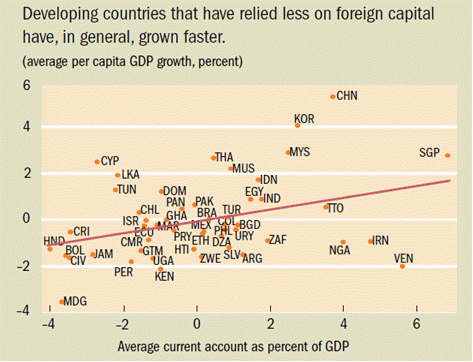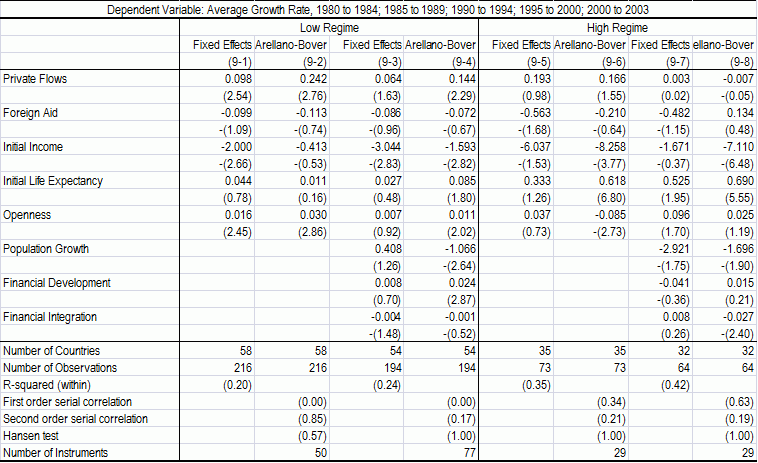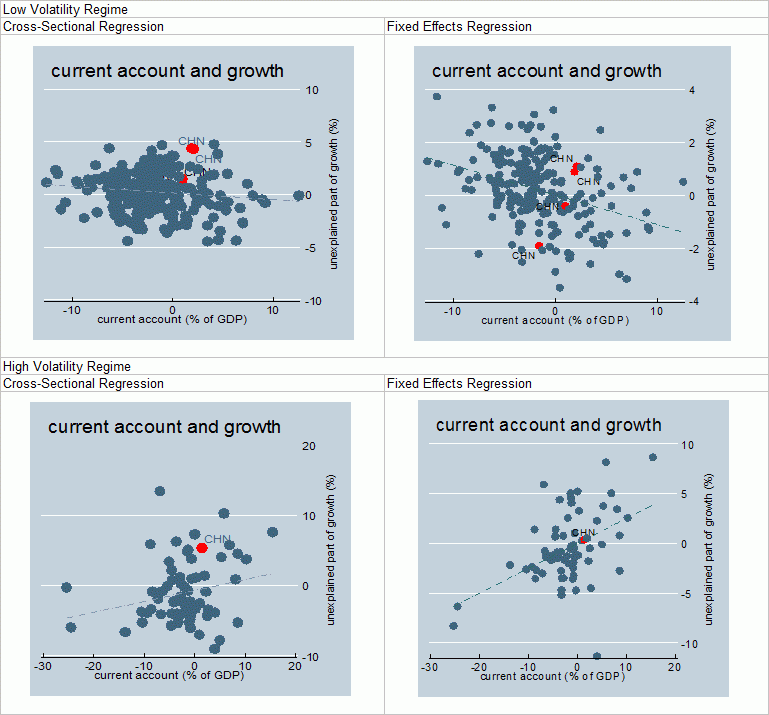In a recent survey, Kose et al (2006) find little robust evidence for long-run growth benefits from global capital inflows. Prasad et al (2006) go a step further. They argue that developing countries grow faster when they rely less on foreign capital, as suggested by a positive relationship between current-account surpluses (capital outflows) and average growth (Figure 1). The conclusion then is that international capital may even hurt economic growth in poor countries.1 This proposition has now acquired the status of a ‘stylised fact’ and is the cornerstone of a growing theoretical literature (eg Gourinchas and Jeanne 2007).
Figure 1. The paradox of capital
Source: Prasad et al (2007).
Yet some are not persuaded by the emerging consensus. They seek to identify the conditions that generate social value in moving capital from rich to poor countries. For example, Arteta et al (2003) conclude that greater policy reform allows more gains from capital account liberalisation. Similarly by interacting FDI with the appropriate measure, Borensztein et al (1998) and Alfaro et al (2004) respectively, show that the effectiveness of FDI increases continuously with the level of education and the maturity of financial markets. Alternatively, the effectiveness of inflows may increase discretely beyond certain conditioning thresholds. The search for such non-linearities, however, has been elusive, as Kose et al (2009) conclude: “The empirical literature has reported many interesting results but the robustness of these results and the estimated thresholds vary widely”.
In recent work (Mody and Murshid 2011), we introduce growth volatility as a threshold variable, which we note varies within a country over time. A current-account deficit, ie a capital inflow, can be beneficial for growth when volatility is below a threshold. This, of course, raises the question whether volatility itself is elevated by capital inflows, in which case our results would lose their force since higher volatility would only be a proxy for larger capital inflows and their harmful impact on growth. Our results however show that particular external factors (global growth, interest rates, and commodity prices) influence an individual country’s volatility, depending on that country’s institutional and locational features; however, capital inflows have no additional statistically meaningful relationship with volatility.
There are good reasons to expect that the productivity of capital will decline as volatility increases. When volatility is high, investment in equipment, technology, and complimentary human capital will be deferred due to the risk of greater planning errors and greater uncertainty about the risk-return characteristics of borrowers. At the same time, we find that high volatility periods are associated with smaller private capital inflows, as greater uncertainty deters investors. Interestingly, the aggregate capital inflows/GDP ratio has not necessarily been lower in the high volatility regime; rather, in the high regime, capital arrives mainly in the form of official aid, which (as Deaton 2010 summarises) is not associated with higher growth.
Using threshold regression methods, developed in Hansen (1996 and 2000), we distinguish two regimes:
- A low volatility regime where growth volatility is less than 5.35% of real GDP, and
- A high regime where volatility exceeds this threshold.2
When we group observations into subsamples based on this classification, the relationship between the current account (capital outflows) and growth is negative in the low volatility regime, especially so within countries over time (Figure 2). In other words, when volatility is low, capital inflows reinforce growth. Above the threshold, the positive correlation between the current account and growth re-emerges, ie, capital inflows are associated with lower growth and this drives the finding for the full sample. The volatility regime is thus central to relationship between capital flows and growth.
While we point to uncertainty as the critical factor influencing how foreign capital affects growth in developing countries, much of the empirical literature on capital flows-growth performance has focused on institutional quality as the differentiating variable. However an analysis based on threshold regressions suggests that capital inflows are not necessarily more effective in countries with stronger institutions. This finding is initially puzzling, since volatility has been linked to the quality of institutions (Acemoglu et al 2003). But it helps to note that while volatility changes significantly over time, institutions do not. Hence, institutions are less able to track regime changes within a country.
Our results show that the quality of institutions is just one of a constellation of factors that combine to determine overall volatility in a country. Rather a country’s volatility arises from the interaction of its location and institutional features with global factors. Location is important because it is associated with production diversity (Malik and Temple 2009). Conditional on these country characteristics, the level and changes in volatility are, to a large extent, the consequence of specific external factors most germane to the economy’s external transactions and including global growth, interest rates, and commodity prices (Burnside and Tabova 2010). Once these considerations are accounted for, international capital flows do not add to the explanation of either the cross-sectional or within-country variation in volatility. Thus, volatility regimes – and with it the effectiveness of capital inflows – can change for exogenous reasons.
Policy implications
In the policy debate on capital controls, a key consideration appears to be volatility generated by capital flows. This is not always explicit, but is reflected in terms such as ‘rebounding’ of capital flows, with the concern being that the ‘rebound’ may complicate the task of policymaking (IMF 2011).
Our finding that private capital inflows are not associated with higher volatility is surprising at first, but is supported by earlier scholarly research (Kray 1998 and Bekaert et al 2006). Indeed, Kose et al (2003) support the possibility that greater financial integration reduces output volatility.
Current thinking among developing-country practitioners does not view capital controls as an ‘either/or’ issue, a perspective that is consistent with our analysis. For example Mohan (2011) points to the success of many emerging markets in slowing the pace of capital inflows, which, he argues, helped maintain policy stability. The emphasis is thus on modulating the amplitude of flows rather than on reducing them.
Modulation of capital flows has the potential to give space for domestic policymaking and financial institutions to adjust. That objective is consistent with our view that harmful volatility arises from an interaction of fragile domestic conditions with external economic developments. To be clear though, our results argue that managing domestic fragilities is the key goal – and that does not always or even primarily require modulating the pace of capital inflows. But such a judgement will be ultimately be made by policymakers in the time and space in which they operate.
Disclaimer: The views expressed here are those of the authors and should not be attributed to the IMF, its management or its Executive Board.
Table 1. Capital Flows and Growth
Notes: The dependent variable is the average growth rate over the following non-overlapping intervals: 1980-84, 1985-89, 1990-94, 1995-99, and 2000-03. Income and life expectancy are initial period values. Flows, openness, population growth, financial development and financial integration are period averages. Each specification also includes time dummies (coefficients not reported). The low regime includes all observations for which volatility of growth was less than or equal to 5.35%; the high volatility regime includes all observations for which volatility exceeded this figure. The numbers in parentheses below the coefficients are robust t-statistics. In the bottom of the table the numbers in parentheses are p-values.
Figure 2. Current account and growth: Volatility regimes
Notes: The graphs show the partial scatters of the average growth rate against the average current-account balance in low and high volatility regimes. Observations are classified as low volatility, if the standard deviation of innovations to the growth rate are less than 5.35% of real per capita GDP, there are classified as high volatility otherwise. In each regime the regression controls for the log of initial real GDP per capita, initial life expectancy and the average volume of trade in each period. The cross-sectional regressions additionally control for the average size of fiscal balances over the entire sample period and a measure of institutional quality taken from hall and Jones. In the panel regressions we control for country specific fixed effects, but remove fiscal balances and institutional quality due to the limited time-variation in these data. The full sample is composed 61 developing countries observed over the following five periods: 1980-84; 1985-89; 1990-94; 1995-99; 2000-03.
References
Acemoglu, D, S Johnson, J Robinson, and Y Thaicharoen (2003), “Institutional causes, macroeconomic symptoms, volatility, crises and growth”, Journal of Monetary Economics, 50(1):49-123.
Alfaro, L, A Chanda, S Kalemli-Ozcan, and S Sayek (2004), “FDI and Economic Growth: The Role of Local Financial Markets”, Journal of International Economics, 64(1):89-112.
Alfaro, L, S Kalemli-Ozcan, and V Volosovych (2011), “Sovereigns, upstream capital flows and global imbalances”, NBER Working Papers 17396.
Arteta, C, B Eichengreen, and C Wyplosz (2003), “When does capital account liberalization help more than it hurts?”, in E Helpman and E Sadka (eds.), Economic Policy in the International Economy, Cambridge University Press,177-206.
Bekaert, G, Harvey, C Lundblad (2006), “Growth volatility and financial liberalization”, Journal of International Money and Finance, 25(3):370-403.
Borensztein, E, J De Gregorio, JW Lee (1998), “How does foreign direct investment affect economic growth?”, Journal of International Economics, 45(1):115-135.
Burnside, C and A Tabova (2010), “Risk, volatility, and the global cross-section of growth rates”, NBER Working Paper 15225.
Deaton, A (2010), “Instruments, randomization, and learning about development”, Journal of Economic Literature, 48(2):424-455.
Gourinchas, P-O and O Jeanne (2007), “Capital flows to developing countries, the allocation puzzle”, NBER Working Papers 13602.
Hansen, B (1996), “Inference when a nuisance parameter is not identified under the null hypothesis”, Econometrica, 64(2):413-30.
Hansen, B (2000), “Sample splitting and threshold estimation”, Econometrica, 68(3), 575-603.
IMF (2011), “Recent Experiences in Managing Capital Inflows: Cross Cutting Themes and Possible Policy Framework”, IMF Policy Paper, April.
Kose, A, E Prasad, A Taylor (2009), “Thresholds in the process of international financial integration”, NBER Working Papers 14916.
Kose, A, E Prasad, K Rogoff, and SJ Wei (2006), “Financial globalisation, a reappraisal”, International Monetary Fund Working Paper 06/189.
Kose, A, E Prasad, A Terrones (2003), “Financial integration and macroeconomic volatility”, IMF Staff Papers 50, 119-42.
Kraay, A (1998), “In search of the macroeconomic effects of capital account liberalization”, Mimeo World Bank.
Malik, A and J Temple (2009), “The geography of output volatility”, Journal of Development Economics, 90(2):163-178.
Mody, Ashoka and Antu Panini Murshid (2011), “Growth from International Capital Flows: The Role of Volatility Regimes”, IMF Working Paper 11/90.
Mohan, Rakesh (2011), “Capital Account Management: Is a New Consensus Emerging?” in Keven Gallagher, Jose Antonio Ocampo, and Stephany Griffith-Jones (eds), Managing Capital Flows for Long-Run Development, Pardee Center for the Study of the Longer-Run Future, Boston University.
Prasad, E, R Rajan, and A Subramanian (2007), “The paradox of capital”, Finance and Development, 44(1).
Prasad, E (2006), “Patterns of international capital flows and their implications for economic development”, presented at the symposium, The New Economic Geography, Effects and Policy Implications. The Federal Reserve Bank of Kansas City, Jackson Hole, Wyoming, August 24-26.




